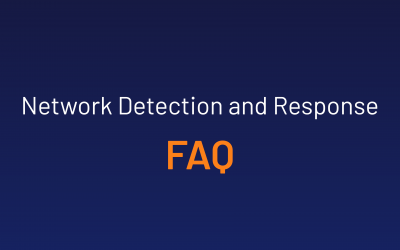It’s no secret that as attackers become more sophisticated, they are increasingly able to evade security measures and infiltrate organizations through a growing number of attack vectors. From remote connections and IoT devices to legacy technologies and cloud environments, the attack surface is growing exponentially
In order to defend against modern cyberattacks, organizations need contextual insights to identify, understand, and prioritize potential threats, improve detection, enhance incident response, and improve overall security posture.
To achieve this, you must be able to gather and analyze data from a wide range of different technologies, software systems, security tools and infrastructure. This includes security tools such as network detection and response (NDR), endpoint detection and response (EDR), security event and information management (SIEM), and more to gain extended detection and response (XDR) for complete coverage.
That’s why ThreatWarrior combines multiple sources of data, analytics, and forensics to provide a true XDR strategy and the Contextual Insights™ to help you stop breaches.
What are Contextual Insights?
Contextual insights refer to the practice of understanding the context in which a security incident or attack occurs, in order to better understand your vulnerabilities, which systems are at risk, and better protect against and respond to future threats. This approach involves analyzing data from various sources, such as network logs, user activity, and external threat intelligence, to gain a comprehensive understanding of the attack and the attackers.
One key aspect of contextual insights is the ability to identify patterns and trends in the data, which can help organizations identify and prioritize potential threats. For example, by analyzing network logs, a security analyst may be able to detect that a particular IP address is repeatedly attempting to access sensitive data, indicating a potential attack. By understanding the context of the attack, such as the time of day, the specific data being targeted, and the type of attack being used, the organization can take steps to prevent similar attacks from happening in the future.
Another important aspect of contextual insights is the ability to use external threat intelligence to gain a broader understanding of the threat landscape. This can include information on known vulnerabilities and exploits, as well as information on specific attackers and their tactics, techniques, and procedures (TTPs).
It can also help organizations to improve their incident response and incident management processes. By understanding the context in which an attack occurred, organizations can more quickly and effectively respond to security incidents, and can take steps to contain and remediate the attack.
The use of contextual insights in cybersecurity is becoming increasingly important as the threat landscape continues to evolve and attackers become more sophisticated. By taking a holistic, data-driven approach, organizations can better protect their networks, data, and users from a wide range of cyber threats.
What is XDR?
XDR is a cybersecurity approach that combines multiple security technologies and data sources to provide a more comprehensive view of an organization’s security posture.
XDR systems typically integrate with various security tools, such as endpoint protection, network security, and SIEM systems. They analyze data from these systems in real-time and use machine learning algorithms to detect and respond to security incidents.
The main advantage of XDR is that it allows organizations to detect and respond to threats that may not be visible with a single security technology. By collecting and analyzing data from multiple sources, XDR systems can identify patterns of behavior that indicate a security incident, and provide a more accurate and complete picture of the attack.
How does XDR compare to NDR and EDR?
While XDR focuses on your organization as a whole and creates a more comprehensive approach to security, NDR focuses on the network and EDR focuses on the endpoint.
NDR involves monitoring and analyzing network traffic to detect and respond to security threats. NDR systems typically integrate with network security tools such as firewalls, intrusion detection systems (IDS), and network flow data to detect and respond to security incidents. The main advantage of NDR is its deep visibility into network traffic and its ability to detect and respond to threats that may not be visible on the endpoint.
EDR solutions monitor endpoints such as servers and laptops and provide rich data and telemetry about the endpoints they are installed on. However, some endpoints and devices cannot have an agent installed upon them, making EDR on its own insufficient in threat protection. Plus, with the explosion of IoT and cloud transformation, it’s not possible to protect your entire network with EDR alone.
XDR is becoming increasingly popular as organizations are dealing with more complex and sophisticated cyber threats, and need to have a more holistic view of their security posture. XDR can help identify threats that may have been missed by a single technology alone, and provide more automated and efficient incident response.
How ThreatWarrior Delivers Contextual Insights
ThreatWarrior delivers contextual insights by leveraging plugins with different functionalities that orchestrate with our central XDR Service. This advanced method allows us to deploy different plugins and capabilities to each ThreatWarrior instance as needed by each customer.
This approach enables users to harness intelligence from a variety of sources including network data, logs, endpoint telemetry, and external threat intelligence, along with leveraging unsupervised deep neural networks, continuous deep packet inspection, behavioral analytics and more to help you build a contextual understanding of your entire organization. We identify and map users, devices, and events across your hybrid and multi-cloud environment, delivering comprehensive insights, packet-level granularity and full-spectrum threat protection.
With ThreatWarrior, you get more than just an endless stream of alerts. We help you thread together the entire threat kill chain so you can understand exactly how a compromise occurred, how you should prioritize and respond to it, and how you can defend against it in the future.
We provide:
Complete Visibility: ThreatWarrior analyzes and correlates information from NDR, EDR, SIEM, software systems, infrastructure, and more to help you achieve a true XDR strategy and see everything happening across your enterprise.
Machine Learning: ThreatWarrior leverages deep unsupervised neural networks to understand your normal operating environment and alert you to any anomalies. Correlated with events and behaviors across your organization, security teams analyze behaviors, determine context, content and intent of observed communication on a network so analysts can take targeted action in real time.
Asset Discovery: ThreatWarrior automatically identifies and classifies anything connected to your network including IoT, traditional endpoints, operational technology and more to provide you with an always-up-to-date asset inventory and a clear picture of what’s on your network.
Deep Packet Inspection: ThreatWarrior observes layers 2 through 7 of the OSI model, delivering deep packet inspection and protocol detection on more than 230 enterprise protocols and more than 6 million traffic classifications. Our platform provides real-time visibility into all network traffic, delivering full-context situational awareness so you know which entities are communicating and what they are communicating.
Contact ThreatWarrior today to learn how we can help you leverage all of your unique data sources to gain the contextual insights you need to better understand attackers and stop breaches.



